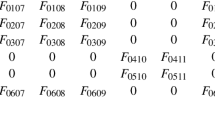Abstract
The Doi-Edwards model with segmental stretch and a non-linear finitely extensible spring law is described and examined in simple flow situations where analytic results are derivable; namely oscillatory flow and steady state flow at high deformation rates. The model is shown to be consistent with the Bueche-Ferry hypothesis in fast large strain unidirectional flows but to violate this rule in small strain reversing flows. The discrepancy is identified with a preaveraging approximation used to describe the relative tube-chain velocity. Experimentally verifiable scaling rule for the birefringence as a universal function of a planar flow-type parameter and deformation rate are identified. Sensitivity to the extensional flow character, absent in the original tube model, manifests itself with the introduction of segmental stretch. Although the model generates a non-separable memory function kernel the deformation dependence of the memory function is quantitatively shown to have negligible impact on the predicted theological properties relative to the original Doi-Edwards model. With this simplification, relatively uncomplicated approximations to the segmental stretch model can be deduced.
Similar content being viewed by others
References
Astarita G (1979) Objective and generally applicable criteria for flow classification. JNNFM 6:69
Bird RB, Curtis CF, Armstrong RC, Hassager O (1987) Dynamics of polymeric liquids. Vol. I, Wiley-Interscience
Booij HC, Palmen JHM (1987) Ideas about reptation, tube renewal and tube relaxation applied to the description of the non-linear viscoelastic behaviour in shear of some polydisperse polyethylene melts. JNNFM 23:189
Boue F, Nierlich M, Jannick G, Ball R (1983) Polymer coil relaxation in uniaxially strained polystyrene observed by small angle light scattering. J Phys 43:137
de Cindio B, Acerno D, Gortemaker FH, Janeschitz-Kreigl H (1977) Transient birefringence of polymer melts in intermittent shear flow. Molecular analysis of the non-linear viscoelastic behavior. Rheol Acta 16:484
Doi M (1987) Basic principle in the viscoelasticity of polymeric liquids. JNNFM 23:151
Doi M (1975) Rotational relaxation time of rigid-like macromolecules in concentrated solutions. J de Phys 36:607
Doi M (1980) A constitutive equation derived from the model of Doi and Edwards for concentrated polymer solutions and polymer melts. J Poly Sci Phys Ed 18:2055
Doi M, Edwards SF (1978a) Dynamics of rod-like macromolecules in concentrated solutions. J Chem Soc Faraday II 74:560–918
Doi M, Edwards SF (1978b) Dynamics of concentrated solutions. J Chem Soc Faraday Trans II 74:1789–1802(1818)
Doi M, Edwards SF (1979) Dynamics of concentrated solutions IV. J Chem Soc Faraday Trans II 75:38
Doi M, Edwards SF (1986) The theory of polymer dynamics. Oxford Science Publications
Fuller GG, Leal LG (1980) Flow birefringence of dilute polymer solutions in two-dimensional flows. Rheol Acta 19:580
Fuller GG, Leal LG (1981) The effect of conformation-dependent friction and internal viscosity on the dynamics of the nonlinear dumbell model for a dilute polymer solution. JNNFM 8:271
Gortemaker FH, Hansen MG, de Cindio B, Janeschitz-Kreigl H (1976) A redesigned cone-and-plate apparatus for the measurements of the flow birefringence of polymer melts. Rheol Acta 15:242
Helfand E, Pearson DS (1982) Calculation of the non-linear stress of polymers in oscillatory shear fields. J Poly Sci Phys Ed 20:1249
Herbolzheimer EA (1991) Personal communication
Janeschitz-Kreigl H (1982) Polymer melt rheology and flow birefringence, Springer-Verlag, Berlin
Kuzuu NY, Doi M (1980) Nonlinear viscoelasticity of concentrated solutions of rod-like polymers. Polymer J 12:883
Larson RG (1983) Convection and diffusion of polymer network strands. JNNFM 13:279
Larson RG (1984) A constitutive equation for polymer melts based on partially extended strand covection. J Rheol 28:545
Larson RG (1988) Constitutive equations for polymer melts and solutions. Butterworths
Lodge AS (1956) Trans Faraday Soc 52:127
Lodge AS (1955) Nature 176:838
Marrucci G, Grizzuti N (1988a) Fast flows of concentrated polymers: predictions of the tube model on chain stretching. Gazzetta Chimica Italiana 118:179
Marrucci G, Grizzuti N (1988b) Topics in molecular modelling of entangled polymer rheology. Proceedings Xth International Congr Rheol Sydney
Marrucci G, Grizzuti N (1986a) The Doi-Edwards model in slow flows. Predictions on the Weissenberg effect. JNNFM 21:319
Marrucci G, Grizzuti N (1986b) The Doi-Edwards model without independent alignment. JNNFM 21:329
Mead DW (1988) Modelling polydisperse polymer melts with single integral constitutive relations. Ph.D. Thesis, University of Cambridge. Department of Chemical Engineering
Mead DW, Leal L, Herbolzheimer EA (1992) The effect of segmental stretch on theoretical predictions of the Doi-Edwards model, Proceedings of the XIth International Congress of Rheology, Brussels 100
Mead DW (1994) Numerical interconversion of linear viscoelastic material functions. J Rheol 38:1769
Osaki K, Bessho N, Kojimoto T, Kurata M (1979) Flow birefringence of polymer solutions in time-dependent field. Relation between normal and shear stresses on application of step-shear strain. J Rheol 23:457
Pearson DS (1987) Recent advances in the molecular aspects of polymer viscoelasticity. Rubber Chem & Tech 60:439
Pearson DS, Kiss AD, Fetters LJ, Doi M (1989) J Rheol 33:517
Pearson DS, Herbolzheimer EA, Marrucci G, Grizzuti N (1991) Transient behavior of entangled polymers in high shear rates. J Poly Sci Phys Ed 29:1589
Roovers J (1986) Linear viscoelastic properties of polybutadiene: A comparison with molecular theories. Polymer J 18:153
Spencer JM (1980) Continuum Mechanics Longmans
Treloar LRG (1975) The physics of rubber elasticity. 3rd Edition Oxford University Press
Wagner MH, Schaeffer J (1992) Constitutive equations from Gaussian slip-link network theories in polymer melt rheology. Rheol Acta 31:22
Author information
Authors and Affiliations
Rights and permissions
About this article
Cite this article
Mead, D.W., Leal, L.G. The reptation model with segmental stretch. Rheol Acta 34, 339–359 (1995). https://doi.org/10.1007/BF00367151
Received:
Accepted:
Issue Date:
DOI: https://doi.org/10.1007/BF00367151




